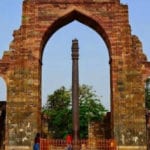 Weird Stuff
Weird Stuff  Weird Stuff
Weird Stuff  Our World
Our World 10 Ways Your Christmas Tree Is More Lit Than You Think
 Movies and TV
Movies and TV The 10 Coolest Stars to Set Sail on The Love Boat
 History
History 10 Things You Didn’t Know About the American National Anthem
 Technology
Technology Top 10 Everyday Tech Buzzwords That Hide a Darker Past
 Humans
Humans 10 Everyday Human Behaviors That Are Actually Survival Instincts
 Animals
Animals 10 Animals That Humiliated and Harmed Historical Leaders
 History
History 10 Most Influential Protests in Modern History
 Creepy
Creepy 10 More Representations of Death from Myth, Legend, and Folktale
 Technology
Technology 10 Scientific Breakthroughs of 2025 That’ll Change Everything
 Weird Stuff
Weird Stuff Ten Bizarre Facts About The Doge Meme
 Our World
Our World 10 Ways Your Christmas Tree Is More Lit Than You Think
 Movies and TV
Movies and TV The 10 Coolest Stars to Set Sail on The Love Boat
Who's Behind Listverse?

Jamie Frater
Head Editor
Jamie founded Listverse due to an insatiable desire to share fascinating, obscure, and bizarre facts. He has been a guest speaker on numerous national radio and television stations and is a five time published author.
More About Us History
History 10 Things You Didn’t Know About the American National Anthem
 Technology
Technology Top 10 Everyday Tech Buzzwords That Hide a Darker Past
 Humans
Humans 10 Everyday Human Behaviors That Are Actually Survival Instincts
 Animals
Animals 10 Animals That Humiliated and Harmed Historical Leaders
 History
History 10 Most Influential Protests in Modern History
 Creepy
Creepy 10 More Representations of Death from Myth, Legend, and Folktale
 Technology
Technology 10 Scientific Breakthroughs of 2025 That’ll Change Everything
10 Discoveries Of Ancient Cultures Nearly Lost To History
“Archaeology will always engage people because it’s putting a puzzle together,” says Shahina Farid of University College London. “And it’s a puzzle we will never, ever complete.” Sometimes, we’re missing pieces of the puzzle and don’t even know it. That’s what makes the following discoveries so exciting. Although we may never know all the details of these mysterious cultures, at least they’re no longer completely lost to history.
10Catalhoyuk
Turkey
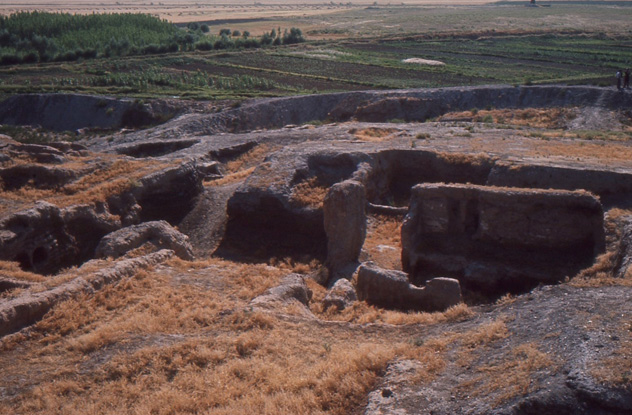
Possibly the first city in the world circa 7400–6000 B.C., Catalhoyuk was an unusual farming settlement of about 8,000 people who lived in rectangular mud-brick buildings built against one another like row houses. But there were no roads or alleys around any of them. People entered their homes through holes in the roof.
“A lot of activity would have taken place at the roof level,” said project director Shahina Farid. “The traversing would have been at the roof level as well. And in between groups of houses were these open areas where they chucked out their rubbish. It’s those areas that are the richest for us because they actually kept their houses very clean.”
Located in central Turkey, Catalhoyuk was discovered in 1958 by a British archaeologist. But the city was almost lost to history again when Turkish officials accused the man in a scandal about missing artifacts. He was never charged, and other archaeologists later absolved him of any wrongdoing. But it was 30 years before another archaeologist was permitted to restart the excavation.
Still, only about 4 percent of the site has been excavated. With every new discovery comes more questions. The people of Catalhoyuk built new houses over the old ones, 16 layers in all. But why did they give up their nomadic lifestyle to settle there in such large numbers? They were farmers, but they didn’t live near their crops. Why not? Where was their food grown?
In addition to sculptures and figurines, paintings rich in symbolism have been well preserved on the plaster walls inside the houses, which doubled as tombs. People were buried beneath the houses with artwork concentrated near burial platforms. Was art a way to communicate with the dead, protect the dead, or perhaps protect the living from the dead?
Interestingly, individuals who lived as a family in Catalhoyuk and were buried beneath a house were not biologically related. Children appear to have lived with people who weren’t their biological parents.
Archaeologists believe the city, which may represent the beginning of civilization, had no leaders or government and that men and women were treated as equals.
9Sanxingdui
China
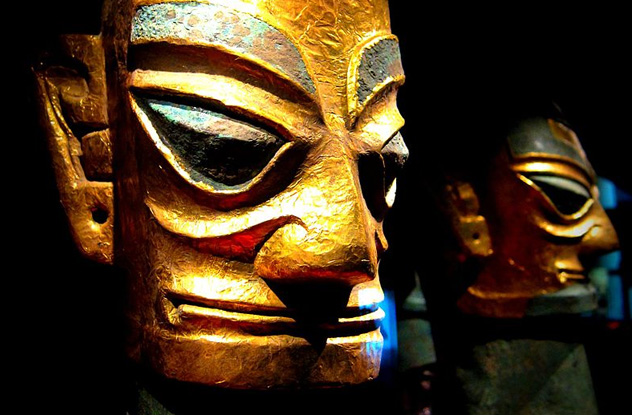
In 1986, archaeologists outside of Chengdu, the capital of China’s Sichuan Province, discovered “the ninth wonder of the world,” an amazing find that has rewritten the early history of China.
They excavated two buried pits of broken bronze sculptures, elephant tusks, and jades dating back to 1200 B.C. These treasures of the mysterious Sanxingdui culture were created in a style previously unknown in ancient Chinese civilization. The bronze pieces were especially impressive, revealing a sophisticated culture with remarkable technical abilities to cast 2.5-meter-high (8 ft) bronze statues unlike anything else that existed in the world at that time.
Archaeologists believe the treasures were sacrifices. But the big mystery is why this lost civilization deliberately destroyed its culture almost 3,000 years ago before leaving the walled city of Sanxingdui by the Minjiang River. The Sanxingdui civilization, which only lasted about 350 years, didn’t leave written records or human remains as clues.
Theories as to why this culture vanished range from war to a flood to an earthquake that may have changed the course of the city’s river.
8Shahr-I Sokhta
Iran
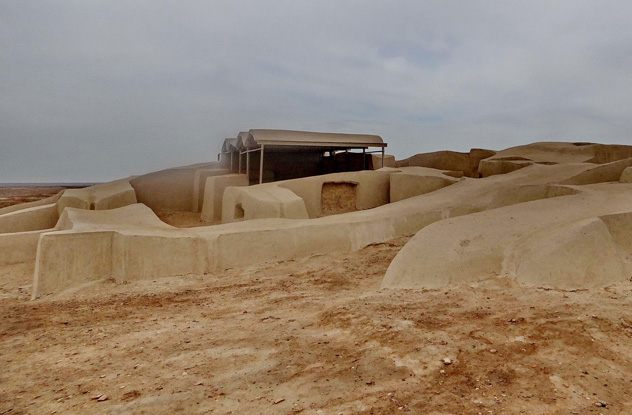
Shahr-i Sokhta (also known as “Burned City” because it burned down three times) was located on the edge of a harsh desert in eastern Iran between 3200 B.C. and about 2000 B.C. After the city was mysteriously abandoned, urban civilizations didn’t reappear in this area for over 1,500 years.
The Shahr-i Sokhta site was first excavated in 1967. But revolution, politics, and crime as well as the harsh climate in the area have made it difficult for archaeologists to conduct their work.
It’s a mystery why this civilization sprang up here. It appears to be an advanced culture that arose independently of Mesopotamia and the Indus Valley Civilization. Shahr-i Sokhta had a large population with one of the first writing systems. They developed the world’s first trade network with other lands in pottery, metals, and textiles, but they kept the best goods for themselves. Although the city had a large, mud-brick palace, the people of Shahr-i Sokhta were also farmers.
For its time, the city was vast at over 150 hectares. Archaeologists discovered a cemetery to the west that has 25,000–40,000 graves. But no weapons have been found, which suggests that the inhabitants of Burned City were peaceful.
7Cacaxtla
Mexico
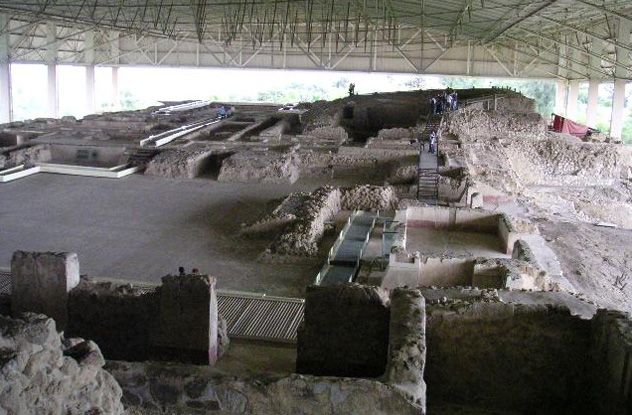
A good deal of what we know about the small city-state of Cacaxtla in Mexico comes from its colorful, complex murals. Over 1,000 years ago, Cacaxtla grew in a modest way with temples, palaces, and some small pyramids. But archaeologists believe that it never became as powerful as Teotihuacan or the Mayan civilization.
In the 1940s, a Spanish archaeologist first surveyed the site. But it took looters digging a tunnel into the city’s main building in the 1970s to revive interest in Cacaxtla. After stumbling upon a complex painting of a “birdman,” the looters confessed their find to a priest, who called Mexican authorities.
The Olmeca-Xicalanca people lived in Cacaxtla as warriors and meticulous builders. Their society appears to have been divided into distinct social strata, but little else is known about them. Their magnificent murals depict colorful scenes of battle, trade, and worship. The Battle Mural is one of the grandest at 2 meters (6 ft) tall and 20 meters (60 ft) wide. It shows a gory scene of armed jaguar warriors prevailing over defenseless bird warriors.
At first, scholars believed that Mayan painters traveled to Cacaxtla to create the murals. But there are so many individual styles in some of the paintings that it seems more likely that several local artists worked on the murals together.
To look at the scenes depicted in the murals, Cacaxtla would appear to have a powerful army, a vibrant economy, and a sophisticated culture. But at least one art history professor, Claudia Brittenham, thinks the portrayal represents the people of Cacaxtla as they wished to be rather than as they truly were. “We sometimes have a terrible habit of thinking of art as though it’s somehow separate from life, as if it’s decorative and not an essential thing,” she said. “In the pre-modern world, that’s not true. All art is political, and the art can be an active agent in creating a sense of community.”
6El Cano
Panama
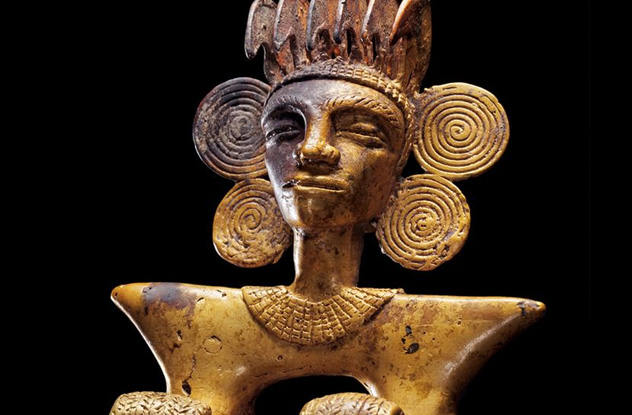
The El Cano site southwest of Panama City has changed historians’ view of the pre-Hispanic cultures that existed in the Central American forests. Buried there are the golden chiefs of Panama, an unnamed culture that existed from A.D. 700–1000. Treasure hunters had searched the area in the early 1900s, but they only found the barren graves of common people.
In the 2000s, archaeologists discovered the graves of warrior chieftains decked out in gold breastplates, belts, bracelets, and arm cuffs. They also found the remains of babies and young boys nearby, similarly adorned with gold. “One of the characteristics of complex chiefdoms is that social status is passed down from father to son,” explained archaeologist Julia Mayo. Her discovery means the golden chiefs’ culture was far more sophisticated than originally thought.
We don’t know a lot about them because they didn’t leave much in the way of historical records—at least, not that we’ve found so far. With structures made of bamboo and thatch, not much survived of their buildings, either. They didn’t leave pyramids for us to study like the Maya did. But archaeologists believe the golden chiefs were a distinct culture that thrived for a time in central Panama.
Their grave sites do give us insight into some of the more unique aspects of their culture, though. For example, the excavators found 15 bodies bundled together to create a platform under one of the chiefs in his grave. It’s unclear if the 15 individuals were slaves or captives. But the archaeologists found a container of pufferfish bones nearby. A pufferfish is highly poisonous, so the experts believe that the 15 individuals were murdered by pufferfish as some sort of sacrifice.
5Gonur-Tepe
Turkmenistan
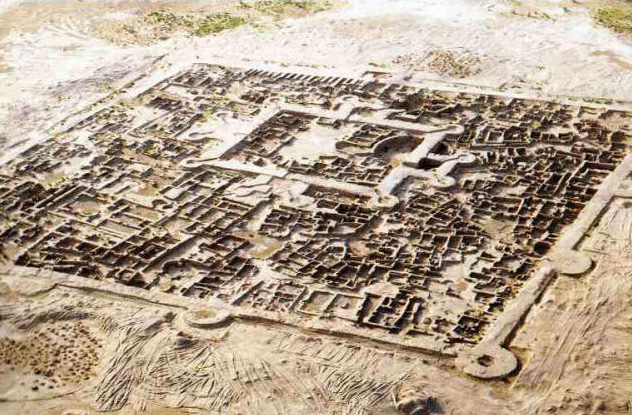
If not for Viktor Sarianidi, a controversial archaeologist from the former Soviet Union who excavated with old-school bulldozers instead of modern dental instruments, we might never have known of the amazing culture at Gonur-Tepe in isolated Turkmenistan. “Everyone opposes me because I alone have found these artifacts,” he raged one day. “No one believed anyone lived here until I came!”
“Tepe” means mound. In treeless regions, these mounds indicate to archaeologists that the ruins of an ancient mud-brick settlement may lie beneath. In the 1970s, Sarianidi persevered over the harsh Karakum Desert to excavate the seemingly barren wasteland of Gonur, which is a little more than 59 kilometers (37 mi) from the city of Mary.
He found the remains of a fortress town and a sophisticated culture that was part of a cluster of settlements stretching across the plains of Central Asia about 4,000 years ago. Surprisingly advanced, Gonur boasted temples, homes, streets, drains, and even canals to irrigate the fields and orchards. Possibly the first city to link the East and the West, Gonur actively engaged in trade with distant cities. Residents were skilled craftsmen who made intricate jewelry from gold, silver, and other metals. Scholars initially believed that such an advanced society couldn’t have existed in this area for at least another 1,000 years.
Western researchers eventually dubbed this lost civilization “Oxus,” after the Greek name for the river that runs through the region. But the enduring mystery is what happened to this city and its thousands of people. Although there are some theories, there’s no real proof. The archaeological records show that Gonur simply vanished after a few centuries.
4Gunung Padang
Indonesia
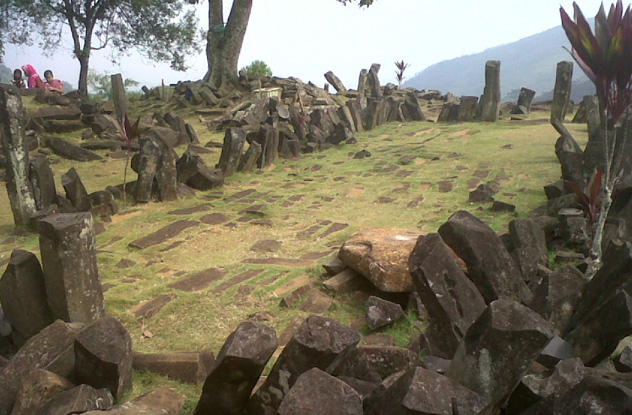
Gunung Padang, the largest megalithic site in Indonesia, is about 120 kilometers southeast of Jakarta. It’s become a source of ongoing controversy between geologist and excavator Danny Hilman on one side and certain professional archaeologists such as Desril Riva Shanti on the other.
Initially discovered by the Dutch in 1914, this little-known site with columns of volcanic rock may be a gigantic terraced tomb from a civilization that existed in 5200 B.C., before the pyramids in Egypt were built. Hilman says his excavation has found an underground room constructed by prehistoric humans. He believes that the entire 100-meter (330 ft) hill, shaped like a pyramid, was built in three phases by three different cultures over thousands of years and could be anywhere from 9,000 to 20,000 years old. If he’s correct, Gunung Padang would become the oldest known pyramid in the world.
“The structure of the building is very good—it’s been defined by many lines of the geo-electric surveys, even 3-D, even [ground-penetrating radar] . . . and core samples,” Hilman said. ”We conclude that the archaeological site, the arrangement of these columnar joints, has laminated the entire hill so it’s 100 meters [330 ft] thick. We also think it’s not just one layer of building, but multiple layers. People think the prehistoric age was primitive, but this monument proves that wrong.”
However, archaeologists like Desril object to the method of excavation, dispute the findings, or both. “I’ve yet to go to the site but I can judge it from photographs,” said Desril. “An archaeological excavation method shouldn’t have been carried out this way.”
Vulcanologist Sutikno Bronto believes the site is not a pyramid but instead the neck of a volcano. He also believes that the carbon dating of cement between the stones is being misinterpreted. His theory is that it’s a natural by-product created by weathering.
Another archaeologist, who preferred to remain anonymous, notes that 9,000-year-old tools made of bones were discovered 45 kilometers (30 mi) away at another site. In view of that, he believes it would have been impossible for humans of 20,000 years ago to have possessed the ability to construct a pyramid.
3Zeleniy Yar
Siberia
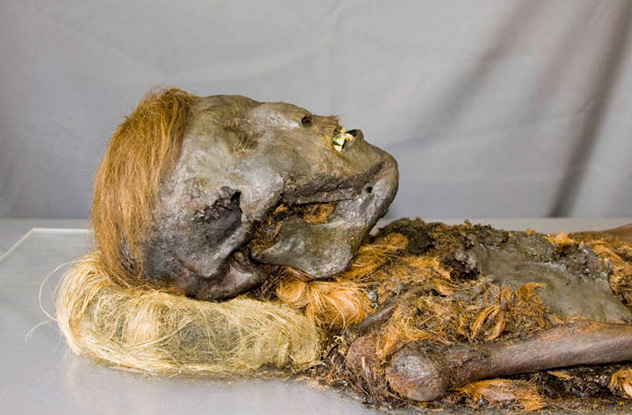
In 1997, Russian archaeologists discovered a medieval Siberian cemetery, Zeleniy Yar, just south of the Arctic Circle. From 34 shallow graves, they excavated mummies—including seven adult males, a female child, and three infant males wearing copper masks—that were about 1,000 years old. The bodies were believed to have been accidentally mummified in the sandy soil by a drop in temperature in the 14th century. In addition, the copper masks and copper plating shrouding some of the bodies may have prevented oxidation. Many of the bodies were covered with animal furs.
Archaeologists had never encountered burial rites like those at Zeleniy Yar. Eleven of the bodies had smashed skeletons with shattered or missing skulls. Archaeologists aren’t sure if grave robbers did this later or if their own people did this at the time of death to protect the living from mysterious spells emanating from the dead. Based on the beliefs of current cultures in the region, researchers believe leather straps encircling the bodies plus beads, chains, and bronze figures smashed into pieces when the bodies were buried are more signs of “protective magic.”
Possibly for religious purposes, the feet of all the bodies were pointed toward the Gorny Poluy River. Some of the dead appear to be warriors who were buried with their weapons. The wounds of others suggest they died in battle. Artifacts found at Zeleniy Yar also contribute to the growing evidence that Siberia was a significant international trading center 1,000 years ago rather than the isolated wasteland many believed it to be.
2Kfar Samir
Israel
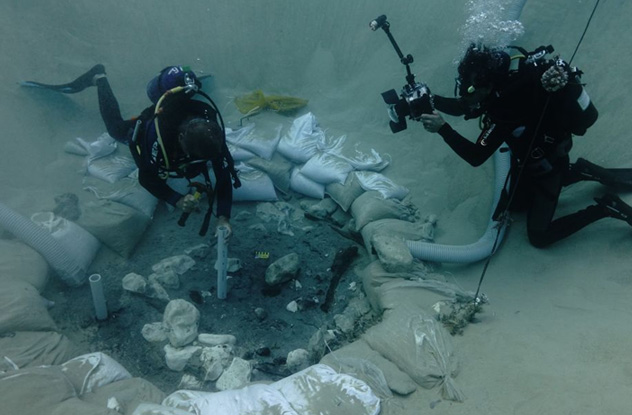
About 200 meters (650 ft) off the coast of Haifa, Israel, archaeologists are exploring a fascinating sunken village called Kfar Samir that’s 7,700 years old and 5 meters (16 ft) underwater. Although the people who inhabited this Neolithic village remain a mystery, this settlement may shed light on both our past and our future.
Using photogrammetry to produce a 3-D model, archaeologists can take their time analyzing the site on land after spending only a few minutes taking pictures of it underwater. The researchers are particularly interested in studying an ancient water well because once the well became salty from the rising seawater, the inhabitants of Kfar Samir probably threw their garbage down it. From an archaeologist’s point of view, garbage contains a treasure trove of information about a lost civilization. The water well may also be among the oldest wooden structures known to man.
“As they were a pre-metal society, we expect to find stone tools—perhaps weapons made of flint and needles made of bone,” said maritime archaeologist Jonathan Benjamin. “Previous excavations suggest this is likely the world’s oldest olive oil production center, and while it’s too early to tell what we’ve sampled from this small excavation, the preliminary results are promising.”
Kfar Samir may also provide some insights into our current climate change and how it’s affecting sea levels. Currently, sea levels are about 100 meters (330 ft) higher than they were during the last ice age more than 20,000 years ago. The coastal settlement of Kfar Samir was submerged by the rising waters about 7,000 years ago. Compared to the present day, the sea level at Kfar Samir was 8 meters (25 ft) lower when it was inhabited, and the coastline was 700 meters (2,500 ft) farther west. Archaeologists believe this gives us insight into how we’ll be forced to cope with rising sea levels from global warming by leaving our cities and homes on the coastlines.
1Nevsehir
Turkey

In December 2014, officials announced the discovery of a massive, ancient underground city in the Nevsehir Province in the Central Anatolia Region of Turkey. It may be the largest underground city in the world. It was accidentally discovered in 2013 by construction workers who had started excavation on an urban renewal project.
Located beneath the conical-shaped Nevsehir fortress and its environs, the city contains hidden churches, escape galleries, dozens of artifacts, and an amazing tunnel system. The tunnels are so wide that you could drive a car through them for most of their 7-kilometer (4 mi) length.
Scientists believe that the site housed an agricultural community 5,000 years ago who used the tunnels to transport their crops to the city. Experts believe at least one tunnel led to a distant water source. The constant temperature of 13 degrees Celsius (55 °F) underground would have been perfect for storing and preserving food.
Nevsehir’s districts have other underground villages and cities. But they would look smaller than the size of a kitchen if placed in this new subterranean complex. No one knows exactly who first built the underground cities in Nevsehir.
